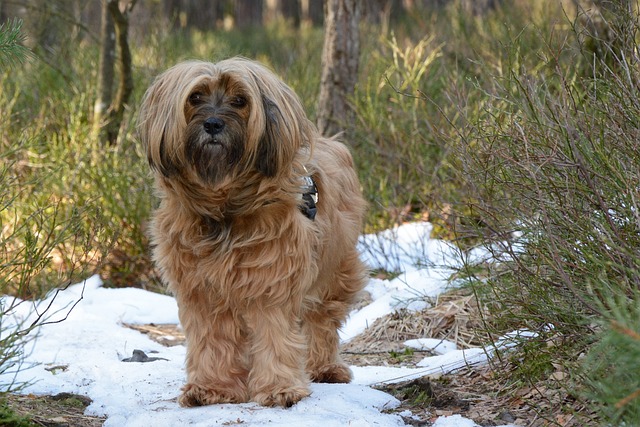History and Origins of the Tibetan Terrier Breed

The Tibetan Terrier is an ancient breed that originated in Tibet, where they were highly treasured as companions, watchdogs, and even luck-bringers. Despite their name, Tibetan Terriers are not true terriers in terms of their behavior or ancestry. They were traditionally kept by Tibetan monasteries and considered “holy dogs” due to their association with good luck and spiritual significance.
Here are some key points about the history and origins of the Tibetan Terrier:
- Ancient Roots: Tibetan Terriers have a long history dating back over 2,000 years in the monasteries of Tibet. They were bred and raised by Tibetan monks, who valued them for their companionship and versatility.
- Utility Dogs: Originally, Tibetan Terriers were kept as multipurpose dogs. They served as herders, watchdogs, and even companions to monks. Their friendly and intelligent nature made them well-suited for various tasks.
- Sacred Status: Tibetan Terriers were highly esteemed in Tibetan culture and were considered lucky charms. They were often given as gifts to bring good fortune to families and were never sold but only gifted.
- Name Misconception: Despite their name, Tibetan Terriers are not terriers at all. The term “terrier” was used by early Western visitors to Tibet who noted their resemblance to some terrier breeds, but their behavior and lineage are quite distinct.
- Export to the West: Tibetan Terriers were brought out of Tibet by European travelers in the early 20th century. The breed was officially recognized by the Kennel Club (UK) in 1937 and later by the American Kennel Club (AKC) in 1973.
Physical Characteristics and Appearance of Tibetan Terriers
Tibetan Terriers are medium-sized dogs with a distinctive appearance that reflects their heritage and original function. Here are the typical physical characteristics and appearance traits of Tibetan Terriers:
- Size: Tibetan Terriers are medium-sized dogs, with males typically standing around 14 to 16 inches (35 to 41 cm) at the shoulder, and females slightly smaller.
- Build: They have a sturdy build with a square-shaped body. They are well-muscled and agile, which reflects their history as working dogs.
- Coat: The most striking feature of Tibetan Terriers is their long, dense, and profuse double coat. The coat can be straight or slightly wavy. They have a fine undercoat that provides insulation in cold climates.
- Color: Tibetan Terriers come in a variety of colors, including black, white, gold, brindle, and tri-color. The coat colors often have subtle variations and can change as the dog matures.
- Head and Expression: They have a distinctive head with a moderate stop and a broad skull. The eyes are large, dark, and expressive, giving them an intelligent and kind expression.
- Tail: Tibetan Terriers have a well-feathered tail that curls over their back, which adds to their elegant appearance.
- Overall Impression: The overall impression of a Tibetan Terrier is that of a balanced, well-built dog with a striking coat and a gentle, friendly demeanor.
Tibetan Terriers make excellent companions for families due to their loyal and affectionate nature. They are adaptable to various living situations but thrive best in homes where they receive plenty of attention and exercise.
Tibetan Terrier Temperament and Personality Traits
Tibetan Terriers are known for their unique temperament and distinctive personality traits. Here’s a look at what you can expect from the temperament of a Tibetan Terrier:
- Loyal and Affectionate: Tibetan Terriers are devoted companions who form strong bonds with their families. They are affectionate dogs that enjoy being close to their human pack members.
- Intelligent: These dogs are highly intelligent and quick learners. They enjoy mental stimulation and are capable of learning a variety of commands and tricks.
- Independent Thinkers: While they are eager to please, Tibetan Terriers also have an independent streak. They may be less inclined to blindly follow commands and may prefer to think for themselves.
- Alert and Watchful: Tibetan Terriers have a keen sense of alertness and make excellent watchdogs. They are naturally suspicious of strangers and will alert their family to any perceived threats.
- Playful and Energetic: Despite their moderate size, Tibetan Terriers are quite energetic and playful. They enjoy interactive play sessions and regular exercise to keep them physically and mentally stimulated.
- Good with Children: Tibetan Terriers are generally good with children, especially if they have been properly socialized from a young age. They are patient and gentle, making them suitable companions for families.
- Social: They generally get along well with other dogs and pets if introduced properly. Socialization is key to ensuring they are well-rounded and comfortable in various social situations.
- Adaptable: Tibetan Terriers can adapt to different living situations, whether in an apartment or a house with a yard. They are adaptable dogs but do require regular exercise to prevent boredom.
Training and Socialization Needs for Tibetan Terriers
Training and socialization are essential for Tibetan Terriers to ensure they grow up to be well-behaved and confident dogs. Here are some training and socialization tips for Tibetan Terriers:
- Early Socialization: Start socializing your Tibetan Terrier puppy from a young age. Expose them to various people, dogs, and environments to help them develop good social skills and confidence.
- Positive Reinforcement: Use positive reinforcement techniques such as treats, praise, and play to motivate and reward your Tibetan Terrier during training sessions. They respond well to gentle and consistent training methods.
- Basic Obedience Training: Teach basic obedience commands like sit, stay, come, and leash walking. Training sessions should be kept short and engaging to prevent boredom.
- Channel Energy: Provide regular exercise and mental stimulation to channel their energy positively. Interactive toys, puzzle games, and agility training can be beneficial.
- Patience and Consistency: Tibetan Terriers can be independent-minded, so patience and consistency are key when training. Stay calm and avoid harsh corrections.
- Watchdog Training: Given their natural alertness, you can channel their watchdog instincts through appropriate training. Teach them to bark to alert you but also to stop when instructed.
- Grooming Practice: Get your Tibetan Terrier used to regular grooming sessions from a young age. This breed requires frequent brushing and maintenance of their coat.
By investing time and effort into training and socialization, you can help your Tibetan Terrier become a well-adjusted and well-mannered companion. Their intelligence and loyalty make them wonderful family pets for those willing to provide them with the care and attention they need.
Health Considerations and Common Issues in Tibetan Terriers
Tibetan Terriers are generally a healthy and hardy breed, but like all dogs, they can be prone to certain health issues. It’s important for owners to be aware of these potential health considerations and to work closely with a reputable breeder who prioritizes the health of their dogs. Here are some common health issues seen in Tibetan Terriers:
- Progressive Retinal Atrophy (PRA): This is a genetic condition that causes the degeneration of the retina, leading to vision loss and blindness. Responsible breeders should screen their breeding dogs for PRA to reduce the risk of passing on this condition.
- Hip Dysplasia: This is a common orthopedic issue in many dog breeds, including Tibetan Terriers. It occurs when the hip joint doesn’t develop properly, leading to arthritis and mobility problems. Regular exercise and maintaining a healthy weight can help manage hip dysplasia.
- Lens Luxation: This is a condition where the lens of the eye becomes displaced due to weakened ligaments. It can cause discomfort and vision problems and may require surgical correction.
- Canine Hypothyroidism: Tibetan Terriers are prone to hypothyroidism, which is a condition where the thyroid gland doesn’t produce enough hormones. Symptoms include weight gain, lethargy, and skin problems. Treatment usually involves lifelong medication.
- Patellar Luxation: This is a condition where the kneecap (patella) dislocates or moves out of its normal position. It can cause lameness and pain, especially when the dog is active.
- Allergies: Tibetan Terriers can be prone to skin allergies and sensitivities, which may manifest as itching, redness, and skin infections. Identifying and avoiding triggers, such as certain foods or environmental allergens, can help manage allergies.
- Dental Issues: Like many small to medium-sized breeds, Tibetan Terriers are susceptible to dental problems such as tooth decay and gum disease. Regular dental care, including brushing their teeth, can help maintain good oral health.
Regular veterinary check-ups, maintaining a healthy diet, providing regular exercise, and attending to grooming needs can all contribute to the overall health and well-being of a Tibetan Terrier.
Living with a Tibetan Terrier: Suitable Environments and Lifestyle Considerations
Tibetan Terriers can adapt well to various living environments, including apartments and houses with yards, as long as their exercise and mental stimulation needs are met. Here are some lifestyle considerations for living with a Tibetan Terrier:
- Exercise Requirements: Tibetan Terriers are moderately active dogs that enjoy daily walks and playtime. Aim for at least 30 to 60 minutes of exercise each day to keep them healthy and mentally stimulated.
- Grooming Needs: Tibetan Terriers have a long, dense coat that requires regular grooming to prevent matting and tangles. Plan for regular brushing sessions several times a week and occasional professional grooming.
- Social Interaction: Tibetan Terriers thrive on companionship and enjoy being part of the family. They do best in households where they receive plenty of attention and interaction with their humans.
- Training and Mental Stimulation: Keep your Tibetan Terrier’s mind engaged with training sessions, puzzle toys, and interactive games. They excel in activities that challenge their intelligence.
- Watchdog Duties: Tibetan Terriers are naturally alert and make good watchdogs. They will bark to alert you to potential intruders or unusual activities, but early training can help manage excessive barking.
- Family Compatibility: Tibetan Terriers are generally good with children and other pets when properly socialized. Supervise interactions with young children to ensure mutual respect and safety.
- Climate Considerations: Their double coat provides insulation against cold weather, but they may struggle in very hot climates. Provide shade and access to cool areas during hot weather.
In summary, Tibetan Terriers make wonderful companions for families who can provide them with the attention, exercise, and care they need. They are adaptable dogs that thrive in loving homes where they are treated as valued members of the family. Regular veterinary care and attention to their specific health and grooming needs will ensure a happy and healthy life for your Tibetan Terrier.
Tibetan Terrier Variations and Breeding Practices

Tibetan Terriers, while a distinct breed, can exhibit some variations in appearance and characteristics due to breeding practices and individual genetic diversity within the breed. Understanding these variations and responsible breeding practices can help prospective owners make informed decisions when choosing a Tibetan Terrier.
Variations in Tibetan Terriers
- Coat Texture and Color: Tibetan Terriers are known for their luxurious double coat, which can vary in texture from straight to slightly wavy. Coat colors can range from black, white, gold, brindle, and combinations of these colors. Some Tibetan Terriers may have more profuse coats than others.
- Size: Tibetan Terriers typically fall within a moderate size range, but there can be slight variations in height and weight. Males generally stand between 14 to 16 inches (35 to 41 cm) at the shoulder, while females are slightly smaller.
- Facial Features: While all Tibetan Terriers have distinct facial features such as a broad skull, moderate stop, and large, expressive eyes, there can be variations in the shape of the head and muzzle.
- Temperament: While Tibetan Terriers share common temperament traits such as loyalty, intelligence, and playfulness, individual dogs may exhibit slight variations in personality. Some may be more outgoing and social, while others may be more reserved.
Breeding Practices
Responsible breeding practices are essential for maintaining the health, temperament, and breed standard of Tibetan Terriers. Here are some key considerations:
- Health Testing: Reputable breeders prioritize the health of their breeding dogs and routinely screen them for genetic health conditions such as progressive retinal atrophy (PRA), hip dysplasia, and thyroid disorders. This helps reduce the risk of passing on hereditary health issues to offspring.
- Breed Standard: Breeders adhere to the official breed standard set by kennel clubs such as the American Kennel Club (AKC) or the United Kennel Club (UKC). This includes specific guidelines for appearance, temperament, and size.
- Genetic Diversity: Responsible breeders aim to preserve genetic diversity within the breed by avoiding excessive inbreeding and selecting breeding pairs based on complementing traits while minimizing the risk of passing on genetic disorders.
- Socialization and Early Development: Ethical breeders prioritize the socialization and early development of puppies, exposing them to various stimuli, environments, and interactions to help them grow into well-adjusted adults.
- Lifetime Support: Reputable breeders provide ongoing support and guidance to puppy buyers, offering resources and advice for the care, training, and health of their Tibetan Terriers throughout their lives.
- Breeding Ethics: Responsible breeders breed for the betterment of the breed rather than for profit. They prioritize the health, temperament, and overall well-being of their dogs over financial gain.
When considering adding a Tibetan Terrier to your family, it’s important to research and choose a breeder who follows these responsible practices. A reputable breeder will be transparent about their breeding program, provide health clearances for their dogs, and welcome questions from prospective puppy buyers. Additionally, consider adopting from rescue organizations or reputable breed-specific rescue groups if you’re open to providing a loving home to a Tibetan Terrier in need.
50 Best Names with Meanings for Tibetan Terriers
Naming your Tibetan Terrier can be a delightful experience, especially when you choose a name that reflects their unique characteristics and your own preferences. Here’s a list of 50 names along with their meanings that could be perfect for your Tibetan Terrier:
- Dharma – Represents the teachings or path of Buddhism.
- Bodhi – Refers to enlightenment in Buddhism.
- Karma – Means “action” or “fate” in Buddhism.
- Lhama – Variant of “lama,” a Tibetan Buddhist monk.
- Yakshi – Refers to nature spirits in Tibetan Buddhism.
- Lotus – Symbolizes purity and enlightenment.
- Samsara – Refers to the cycle of life, death, and rebirth in Buddhism.
- Champa – Tibetan flower, symbolizing purity.
- Tashi – Means “good fortune” or “auspiciousness.”
- Sherpa – Refers to the ethnic group known for mountaineering.
- Sangha – Refers to the Buddhist community.
- Kailash – Sacred mountain in Tibet.
- Jampa – Means “loving-kindness” in Tibetan.
- Nima – Means “sun” in Tibetan.
- Yangchen – Means “goddess” in Tibetan.
- Pema – Means “lotus” in Tibetan.
- Dolma – Refers to the female bodhisattva of compassion.
- Tenzin – Common Tibetan name, often associated with the Dalai Lama.
- Lhasa – Capital city of Tibet.
- Kunga – Means “all-knowing” or “omniscient” in Tibetan.
- Sonam – Means “merit” or “good fortune.”
- Rigzin – Means “precious one” in Tibetan.
- Norbu – Means “jewel” or “gem” in Tibetan.
- Kelsang – Means “good fortune” in Tibetan.
- Jigme – Means “fearless” or “brave” in Tibetan.
- Rinchen – Means “precious” or “jewel” in Tibetan.
- Diki – Means “good luck” in Tibetan.
- Thubten – Means “blessings” or “virtues” in Tibetan.
- Yeshi – Means “wisdom” in Tibetan.
- Lhundup – Means “spontaneously accomplished” in Tibetan.
- Palden – Means “glorious” or “excellent” in Tibetan.
- Dorje – Means “indestructible” or “diamond” in Tibetan.
- Tsomo – Means “gathered like a lake” in Tibetan.
- Chomolungma – Tibetan name for Mount Everest.
- Phurbu – Means “magic dagger” in Tibetan Buddhism.
- Tashi – Means “auspiciousness” or “good fortune.”
- Dawa – Means “moon” in Tibetan.
- Yangzom – Means “goddess of wisdom” in Tibetan.
- Gyatso – Means “ocean” in Tibetan.
- Ngawang – Means “powerful speech” in Tibetan.
- Tashi – Means “auspiciousness” or “good fortune.”
- Tsering – Means “long life” in Tibetan.
- Trinley – Means “wish fulfilling” in Tibetan.
- Wangmo – Means “goddess” in Tibetan.
- Dorje – Means “thunderbolt” or “diamond” in Tibetan.
- Gyaltsen – Means “victorious” in Tibetan.
- Dolkar – Means “white crystal” in Tibetan.
- Jamphel – Means “kindness” or “love” in Tibetan.
- Lhamo – Means “goddess” in Tibetan.
- Tsering – Means “long life” in Tibetan.
Choose a name that resonates with you and your Tibetan Terrier’s personality or that holds special meaning to you. Whether it’s a name inspired by Tibetan culture, Buddhism, or simply a beautiful-sounding name, your Tibetan Terrier will appreciate the love and attention that comes with their unique name.

In conclusion, the Tibetan Terrier is a captivating and versatile breed with a rich history rooted in Tibetan culture. Renowned for their intelligence, loyalty, and adaptability, Tibetan Terriers make excellent companions for families and individuals alike. Their unique coat requires regular grooming to maintain its beauty and health. With proper care and training, this breed thrives in various environments and forms deep bonds with their human companions. Consider welcoming a Tibetan Terrier into your life if you’re seeking a loving, spirited, and resilient canine companion.






























